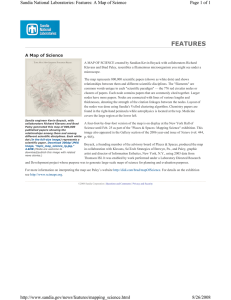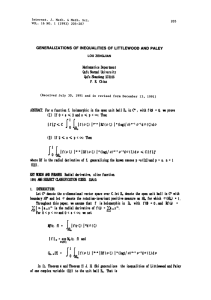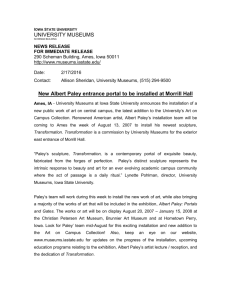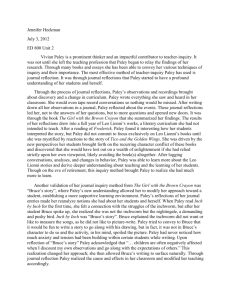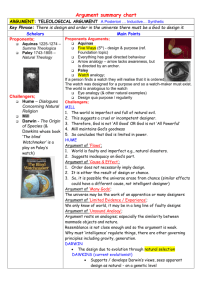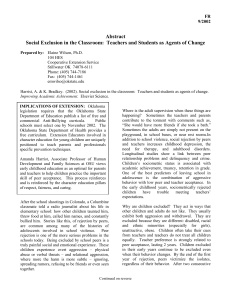The Morality of Orality: Grace Paley's Stories Please share
advertisement
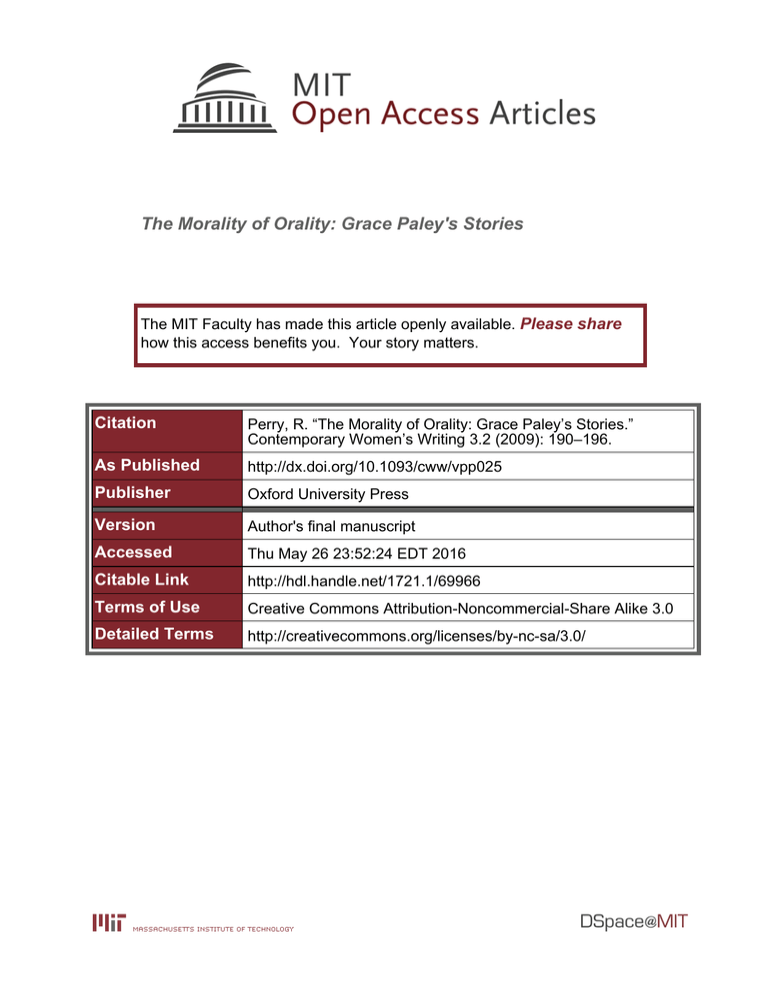
The Morality of Orality: Grace Paley's Stories The MIT Faculty has made this article openly available. Please share how this access benefits you. Your story matters. Citation Perry, R. “The Morality of Orality: Grace Paley’s Stories.” Contemporary Women’s Writing 3.2 (2009): 190–196. As Published http://dx.doi.org/10.1093/cww/vpp025 Publisher Oxford University Press Version Author's final manuscript Accessed Thu May 26 23:52:24 EDT 2016 Citable Link http://hdl.handle.net/1721.1/69966 Terms of Use Creative Commons Attribution-Noncommercial-Share Alike 3.0 Detailed Terms http://creativecommons.org/licenses/by-nc-sa/3.0/ July 22, 2009 Ruth Perry 14N-415 MIT Cambridge,MA 02139 rperry@mit.edu THE MORALITY OF ORALITY: GRACE PALEY‘S STORIES The late Grace Paley was one of the great writers of the twentieth century, loved for her humanity and humor and admired for her brilliant, witty, deeply provocative prose fiction. Her literary voice is sui generis—pungent, familiar, and utterly recognizable--yet few know how to place her fiction. It could be categorized in the vernacular tradition of American literature, because the speech of her narrators is not the elevated voice of the belles lettres establishment but the regionally specific colloquial speech of ordinary persons. According to Leo Marx, Walt Whitman and Mark Twain were the earliest practitioners of the American vernacular; their narrators spoke not English but American, affirming their particular regionality against the faceless gentility of the east coast or of Europe, and the democratic equality of all men against the hierarchies of race and class.i Grace Paley‘s narrators, ordinary middle-aged women, push this radical equality further. Their colloquial speech and daily concerns challenge conventional literary notions of the subject matter of fiction as well as the class, gender, and racial identities of its speakers. But there is something else going on in Paley‘s fiction, besides rafting along in the mighty river of American vernacular literature. You can hear it in the titles of her stories: ―Conversation with My Father,‖ ―The Loudest Voice,‖ ―Listening‖ ―Zagrowsky Tells.‖ Although about many different topics, her stories are built on talk, on direct faceto-face conversation between people rather than third person narration or wordless 1 incident. As Paley affirmed in many different interviews (and characteristically, the interview is the most common critical format for treating her work) her writing process always began with the spoken language, with voices sounding in her ears. She often spoke those words aloud before writing them down. The rhythms of ordinary speech were her inspiration. Indeed, she wrote as if she were a compositor of the oral, and the social conditions of the occasions she described are predominantly those of a specific speech community. In ―Friends,‖ she gives that social configuration a name: she calls it a ―private, inclusive, intentional community‖ and refers to her story as a ―report‖ for ―my friends and our children…on these private deaths and the condition of our lifelong attachments‖ (315).ii Not only is this a distinctive aesthetic basis for her fiction, but it implies a political position as well. ―Friends‖ describes a visit from Faith and two other women to their dying friend, Selena, and their conversation during the train ride back. These women have known one another a long time. Their children have grown up together. Their friendship has outlasted husbands and lovers who have come and gone. In the story, they talk to one another and they talk about one another. There is very little third person narration; the story is made up of the voices of these friends. Paley‘s preference for the diction of speaking voices—despite the obvious fact that her stories are written, printed, and read silently by a literate audience—projects the kind of world that she both wished for and imagined. It is a world in which people face one another without the mediation of print, bureaucratic institutions, or other abstract or alienating feature of modern life. The oral communities that Paley‘s prose fiction represents presume relationships built on direct contact and shared daily experience. In 2 her stories, even the private, interior, solitary thought of the central protagonist is externalized as a running series of remarks or wisecracks--a superstructure of dialogue that the narrator maintains with the reader. Human relations in her stories always come back to this common denominator of face-to-face contact despite the complexity of the modern world in which her characters live; the ease and simplicity of their relations, their directness, is part of the charm of her stories. Thus, the story ―Politics,‖ begins: ―A group of mothers from our neighborhood went downtown to the Board of Estimate hearing and sang a song.‖ (220) Distance and mediation are stripped away; there are no letters, emails, newspaper reports, television or radio announcements at second hand. No guards stop them at the door; no one makes them wait. It is magical realism without the magic; their surreal act requires no technological assistance or special talent—just their presence and their human voices. The qualities of written language and spoken language are different, of course, and Paley‘s genius is to evoke the phenomenological qualities of the oral by means of the written. According to one study, ―spoken language is characterized by complex sentence structure with low lexical content (more clauses, but fewer high content words per clause); written language by simple sentence structure with high lexical density (more high content words per clause, but fewer clauses.‖iii That is, written language appears to be more condensed and abstract than spoken language. These differences are shaped to the very different needs, circumstances and living arrangements of those who live in literate or non-literate cultures. Memory operates very differently in the two kinds of cultures and they foster different kinds of extrapolations from experience. In reviewing the literature on written and spoken language, Wallace Chafe and Deborah Tannen set out 3 what they call the ―Great Divide Hypothesis‖ (traceable to the work of the classicist Walter Ong, the anthropologist Jack Goody, and the psychologist, D. R. Olsen) which distinguishes between the oral and the literate as follows. ―Briefly, the orality-literacy hypothesis posits that writing makes possible verbatim memory and abstract and sequentially logical thought, and that written discourse is de-contextualized or autonomous, whereas non-literate culture is associated with constructive memory and concrete and rhapsodic thought, and that spoken discourse is context-bound.‖iv As Chafe and Tannen make clear, a number of amendments and correctives to this hypothesis have been made from different disciplinary standpoints, but it nonetheless remains a powerful distinction in anthropology and linguistics. Writing can separate the knower from what is known; the author, often at some distance from the narrator, is frequently hidden from the reader. The intelligence conveyed in writing is independent of its source, its process, its history. Writing enables ―verbatim memory‖ and ―sequentially logical thought,‖ preserving ideas, facts, and connections even when the cognitive process of the individual author is interrupted or even forgotten. In oral cultures, ―words never exist in a purely verbal context as the written word does‖v but are part of a total existential situation. Oral situations tend to situate the knowers and their knowledge in the here-and-now with a fully understood context for the spoken words. The speaker is right there—face-to-face—telling the story to the storyhearers, and they all inhabit the same world together. Paley‘s stories, though written, evoke this oral situatedness. They often have a highly specific sense of place. We always know who is speaking and where they are coming from—just as the sandwiches in the Arts Food Deli are named for people in the neighborhood. Oral/aural situations 4 tend to inclusive social arrangements; everyone within earshot can be part of the event, not just a single pair of eyes trained on the printed page. Sound surrounds groups of people, bringing them together; speeches and concerts unite people in groups whereas silent reading separates individuals into their own private worlds. Paley‘s stories are never interested in this kind of intense individual consciousness of characters alone. The events of her stories, such as they are, tend to happen to people in groups; for instance—the mothers in the playground, the other people in the Arts Food Deli, the crowd in a store, the Jewish neighborhood where ―every window is a mother‘s mouth‖ (34) or the three friends who take the train to see their dying friend Selena. They reproduce and recount the face-to-face interactions of people in those small social groups. ―Tribal‖ is a word Paley uses for the communities she writes about—a word which denies that major twentieth-century literary trope of the huge, faceless anonymous mass culture that so many modernist writers have told us we are immersed in and victim to. In ―Friends,‖ we learn that when these women were in the PTA together, they decided to offer tutorial help to immigrant kids whose first language was Spanish. Faith tells us that every week she worked with Robert Figuerora (the people in her stories have names) first at storytelling and then at writing ―the beautiful letters of the alphabet invented by smart foreigners long ago to fool time and distance.‖ (307) But time and distance here are collapsed into a political present, rather than relegated to the there-andthen of print. In this story her main character, who is after all teaching reading and writing, does so personally, one-on-one, not by computer or from a workbook or in front of a class. More like a mother teaching a child or an older sibling teaching a younger one 5 than a teacher in a public school, she teaches by doing, by telling stories and then showing Robert Figuerora how to write them down. Even in this snippet about teaching literacy, the oral is primary and literacy begins as ancillary to it. Many of Paley‘s stories have a political edge to them, and the political confrontations or actions they describe resemble her own personal commitment to direct action and face-to-face contact. As she says when describing her weekly meetings with Robert Figuerora in ―Friends‖: ―Though the world cannot be changed by talking to one child at a time, it may at least be known.‖ The most profound political action entails knowing the other directly. Paley always spoke directly to policemen patrolling the demonstrations she took part in, and to Vietnamese people during her trips there while the U.S. was at war. The women of the neighborhood in ―Zagrowsky Tells‖ talk to Zagrowsky about his racist treatment of their friend Josie; they confront him directly before resorting to picketing his pharmacy. Paley believed trying to change the world beginning where you lived. She participated in many non-violent direct actions and acts of civil disobedience; she was jailed several times for testifying with her voice and her body that she did not believe in nuclear power plants or the power of the Pentagon to wage war in other countries. She was deeply interested in the ―refuseniks‖ in Israel who refuse to participate in military actions that oppress their Palestinian neighbors. Their passive resistence to orders they believe to be wrong, their use of free speech, and the immediacy of their words and actions appealed to her moral sensibility. Even in her piece about being jailed for civil disobedience, ―Six Days: Some Rememberings,‖ she tells it as a story about people speaking directly to one another, both in and out of jail. Her incarceration takes place in a prison in her neighborhood where she 6 can watch people she knows come and go. Friends and family of those in jail stand on the street and shout up to the women in the cell block, who shout back, from several stories up. Paley be-moans the fact that she has no pen and paper for those six days she spends in jail, because she cannot write down anything, but is forced to make do with what she can remember of what happens. In the dark at night, voices ask Rita, one of the women, to sing to them; and she sings several long ballads, songs that tell stories, with more than twenty verses in each one. Frustrated that she will not be able to remember the long ballad, and that she is unable to get any of the words down in writing, Paley realizes that the literacy-based educational system that discouraged her ―memorizing mind‖ has done a great disservice to her generation. The ―memorizing mind‖ that enables the ballad singer is, of course, a significant feature of oral cultures, condemned in Paley‘s world as ―rote learning,‖ ―old-fashioned‖, and ―backward, an enemy of creative thinking.‖ But she realizes that this policy has disabled ―a great human gift,‖ essential to all human cultures for centuries before print.vi Over and over, Paley‘s imagination evokes a world of oral/aural connection. She wakes her sons ―who should really be old enough to understand an alarm clock when it speaks to them—without their mother‘s translation.‖ (382) Teachers in ―The Loudest Voice‖ become happier and happier as the time draws closer to the Christmas break, ―Their heads were ringing like the bells of childhood.‖ (36) Her stories describe aural/oral worlds filled with noisy sounds: ―There is a certain place where dumbwaiters boom, doors slam, dishes crash; every window is a mother‘s mouth bidding the street shut up, go skate somewhere else, come home‖ (34). She writes with deliberate grammatical irregularities that emphasize the differences between written and speech 7 standards.vii In ―Zagrowsky Tells,‖ ―[t]he park is full of noise. Everybody got something to say to the next guy. Playing this music, standing on their heads, juggling—someone even brought a piano, can you believe it, some job‖ (363). Even on the page, the words have an accent; we hear the rhythms of a specific, local speech community. In non-literate cultures, sustained thought is tied to communication with others. When writing does not signify, speech happens in real time rather than referring to something else; speech is the event, it is what happens. Print is just a holding action in Paley‘s stories. ―He turned to the class. ‗Children, not a sound. Open at page 39. Read till 52. When you finish, start again‘‖ (35). Everything important in these stories happens in talk. The action is built up of bits of conversation and every word is a little bridge connecting people. Talk matters: ―Why don‘t you tell my story?‖ asks Cassie in ―Listening.‖ ―You‘ve told everybody‘s story but mine…I do not forgive you‖ (385-6). Talk can be painful, but it is also balm and comfort. In ―Friends,‖ Ann sits more easily in her chair after Selena mentions Mickey, her son lost to drugs. Just having his name spoken aloud, ―She was able to rest her body a little bit‖ (312). And even old Zagrowsky, the pharmacist, as he prepares to tell Faith about his daughter‘s child, thinks ―Tell! That opens up the congestion a little—the lungs are for breathing, no secrets‖ (355). Ethnographers tell us that older people are valued more in oral cultures because of the lifetimes of experience and memory that they carry with them. Not coincidentally, Paley‘s fiction valorizes older people, like her father, who knows many things and often imparts them in the form of facts and advice to his middle-aged daughter. A number of her stories are about divorced men and women, no longer in their first flush of youth, 8 living together. In ―Listening,‖ she writes about the sexuality of the ―later-in-life, which has so much history and erotic knowledge but doesn‘t always use it‖ (383). Lived experience rather than advice from books–this is how the wisdom of age manifests itself in Paley‘s stories—sometimes direct from one generation to another. Although one obviously reads them on the page, Paley‘s words resonate in the mind as speech: personal, immediate, direct, living. In ―Goodbye and Good Luck,‖ Rose Lieber is talking to her niece Lillie on her wedding day, telling her the story of her relationship to Volodya Vlaskin, the Valentino of Second Avenue, the ―topic of my life,‖ whom she is about to marry. In the telling, many things are discussed—her family, who disapproved of her, her father and mother‘s miserable marriage, her sister Ruthie, the various men who proposed to her and made love to her—each with a characteristic little snatch of speech to demonstrate who they are. The story adds up these bits and pieces, the way oral texts do in a paratactic structure, rather than having a beginning, middle, and end, an arc of action or a climactic event to which all else is subordinated. As in oral literature, there is much formal repetition in Paley‘s stories and incantatory verbal echoes. Rosie says ―goodbye and good luck‖ three times in the story of that name, each time in a different context; ―‘Rosie, Rosie,‖ Vlaskin says to her, ―I can see by the clock on your rosy, rosy face you must be thirty‖(9). It is a sentence that makes you want to say it out loud. In Paley‘s unconventional prose, adjectives hold the nouns in place. As in oral ballad literature, where no knight simply rides a steed—it is always a milk-white steed-and every maid is a fair maid, so Paley does not leave her nouns unadorned. But her adjectives are idiosyncratic rather than formulaic, and they are part of what gives her 9 prose its characteristic flavor. Richard‘s ―nosy ear‖ (383); ―A few hot human truthful words‖ (303); Selena‘s ―stubborn face‖ becomes her ―useful stubborn face‖ –incremental repetition--(307); ―windy courtyard trees‖ (311); and even ―him-itis, the dread disease of females‖ (307), a newly minted word to make a joke with an old cliché. Paley‘s method of composition—indeed her entire way of life—was based on speaking and listening. She wrote poems during her work sessions to limber up her writing mind. She always read her work aloud while writing to see if it sounded right. In teaching, she had her students read their stories aloud to one another without distributing copies. She wanted their words to be heard rather than read. She always said that one of the things she was teaching was listening. ―It‘s really almost a political thing for me to pay attention to [spoken stories]‖ she said.viii Reading aloud, she said, slowed down the story so you could pay proper attention to it. ―Because the eye is such a speedy thing,‖ she said. ―The eye goes zzt, zzt, zzt, you know? The ear says, ‗Wait.‘‖ Thus she explains her method for teaching writing with a little conversation between her ears and eyes, her way of scrutinizing the written word translated into the oral realm. Paley travelled around the country and the world in order to read in person, to give workshops, and to see people. She was always travelling—even at the end when she was sick—in order to be bodily in other cities and other countries and to read her work aloud in her own voice, along with conveying certain non-verbal aspects of oral communication such as intonation, body language, and facial expressions. Although travel could tire her out, and getting from one place to another was exhausting, the talk and direct contact with people enlivened her and gave her strength. She would go to a reading tired, and then, after hugging and greeting dozens of her friends and fans 10 afterwards, she would emerge cheered up and ready for a quiet chat and a calming cup of tea. At home, her phone was constantly ringing. She was, as Jacqueline Taylor wrote, ―extraordinarily accessible by phone to both friends and strangers.‖ix For many writers, literary language is an attempt to preserve the immediacy, the freshness, the authenticity of spoken language. Even without Grace Paley managed that in her fiction. But it was more than a trick of the ear with her. There was a consistent experiential node in Paley‘s life, her politics, and her art that had to do with direct and honest contact with others. She lived and worked in groups, and the quality of her mind and thought came in part from its uses in relation to others. Her fiction models a way of being in the world in which characters know what they think and feel and are able to speak these thoughts and feelings with humor and economy to one another. Their directness satisfies our yearning for less alienated human relations. And in reading her stories we feel that the world might be a better place if people could learn how to put their hearts and minds in better touch with each other, and then to talk to one another— loudly, irreverently, honestly, combatively, clearly, and humorously—the way people do in Grace Paley‘s stories. 11 i Leo Marx, ―American Vernacular,‖ in The Pilot and the Passenger: Essays on Literature, Technology, and Culture in the United States (Oxford and New York: Oxford University Press, 1988) 3-17. ii The page numbers for this and all the stories quoted here come from Grace Paley The Collected Stories (New York: Farrar Straus Giroux, 1994). iii M. A. K. Halliday, ―Differences between spoken and written language: some implications for literacy teaching, in Communication Through Reading Proceedings of the Fourth Australian Reading Conference, ed. G. Page, J. Elkins, B. O‘Connor quoted in Wallace Chafe and Deborah Tannen, ―The Relation between Written and Spoken Language,‖ in Annual Review of Anthropology, 16 (1987): 383-407, esp. p. 388. iv Chafe and Tannen, ―Written and Spoken Language,‖ p. 391. v Walter Ong, Orality and Literacy: The Technologizing of the Word (1982; New York: Methuen, 1988) 67. vi ―Six Days: Some Rememberings.‖ which is not fiction does not appear in her Collected Stories but in Just As I Thought (New York: Farrar Straus Giroux, 1998) 24-30. vii Thanks to William Donaldson for this formulation. viii Jacqueline Taylor, ―Grace Paley on Storytelling and Story Hearing,‖ Literature in Performance 7 (1987): 46-58, esp. p. 47. ix Jacqueline Taylor, Grace Paley: Illuminating the Dark Lives (Austin: University of Texas Press, 1990) 92. 12

